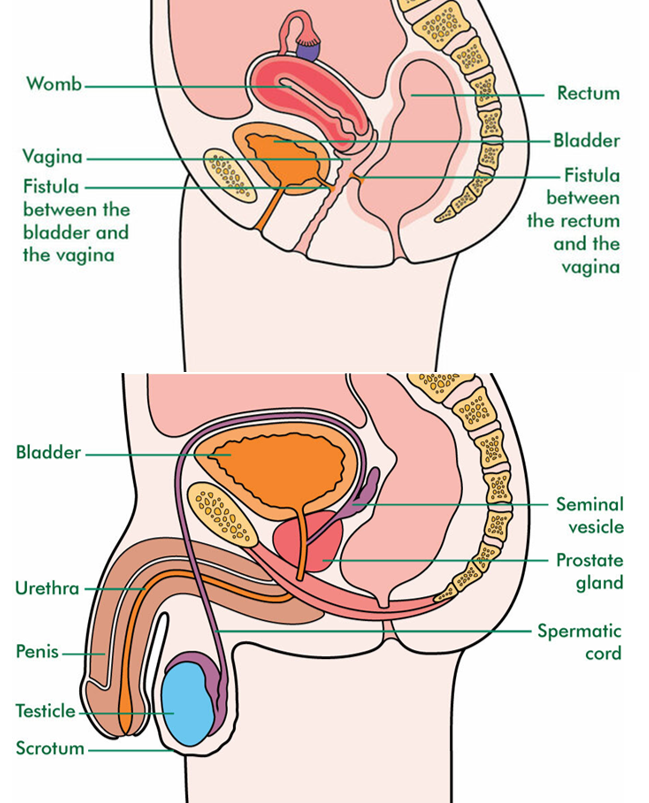Every year, about 10,000 people in the UK are diagnosed with bladder cancer. Of these, 8 out of 10 (80%) are diagnosed with early bladder cancer.
Am I at risk?
The bladder is a hollow and muscular organ that collects and stores urine (pee). There are certain things that can affect the chances of developing bladder cancer. These are called risk factors.
The main risk factors are;
- Age – It is rare in people under the age of 40
- Smoking – Smoking is the main cause in about 4 in 10 (40%) of bladder cancers
- Gender – Bladder cancer is more common in men than in women
- Exposure to chemicals at work – These include chemicals previously used in dye factories and industries.
- Infection – Repeated urinary infections and untreated bladder stones are linked to a less common type of bladder cancer called squamous cell cancer
- Previous treatment for cancer
- Diabetes
- Family history
For more information on the causes and risks of bladder cancer please follow this link.
Types of bladder cancer
- Urothelial bladder cancer
This is the most common type of bladder cancer. It is also called transitional cell carcinoma (TCC). It starts in cells in the bladder lining. These cells are called urothelial or transitional cells. Bladder cancer may be non-muscle-invasive, muscle-invasive or advanced.
- Non muscle invasive bladder cancer
This is when the cancer cells are only in the inner lining of the bladder. They have not spread (invaded) into the muscle layer - Muscle invasive bladder cancer
In muscle-invasive bladder cancer, the cancer has spread into or through the muscle layer of the bladder.
- Advanced bladder cancer
Advanced bladder cancer is when the cancer has spread to other parts of the body.
- Less common types of bladder cancer
Less common types of bladder cancer include:
• squamous cell cancer
• adenocarcinoma
• small cell bladder cancer.
These start from different types of cells in the bladder lining and are usually muscle-invasive.
For more information about these types of bladder cancer there is more information in the Understanding muscle-invasive and advanced bladder cancer.
For more information on the types of bladder cancer, please follow this link.
Symptoms of bladder cancer
Most people with these symptoms will not have bladder cancer. They can be caused by an infection or stones in the bladder or kidney. But if you have any symptoms, it is important to get them checked by your GP. The earlier bladder cancer is diagnosed, the more likely it is to be cured.
We understand that showing any symptoms of what could be cancer is worrying. The most important thing is to speak to your GP as soon as possible.
• Blood in the pee (haematuria)
This is the most common symptom of bladder cancer. It can happen suddenly and may come and go. Your pee (urine) may look pink, red or sometimes brown. You may see streaks or clots of blood in it. If you see blood in your pee, it is important to get it checked by your GP as soon as possible.
Sometimes blood in your pee cannot be seen and is found during a urine test. This is called non-visible or microscopic haematuria. If you have urinary symptoms, your GP will ask you to give them a sample of urine. They test this for non-visible blood.
• Urinary symptoms
Some people may:
- have a burning feeling when they pee (pass urine)
- need to pee more often
- need to rush to the toilet to pee.
- These symptoms are usually caused by an infection or an overactive bladder rather than cancer. Some people may need more tests to find out the cause of their urinary symptoms.
- Pain in the lower part of the tummy or back
• Pain in the lower part of the tummy or back is less common, but it may happen in some people.
For more information on the symptoms of bladder cancer, follow this link.
For more information on the symptoms of bladder cancer, follow this link.
Patient information
For more information from Macmillan regarding bladder cancer, please follow this link.
For more information from Cancer Research UK regarding bladder cancer, please follow this link.
